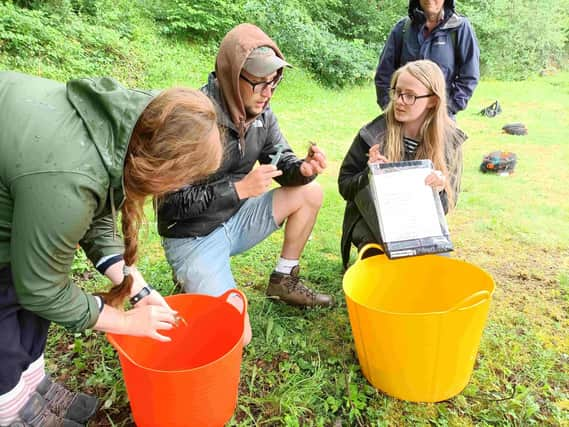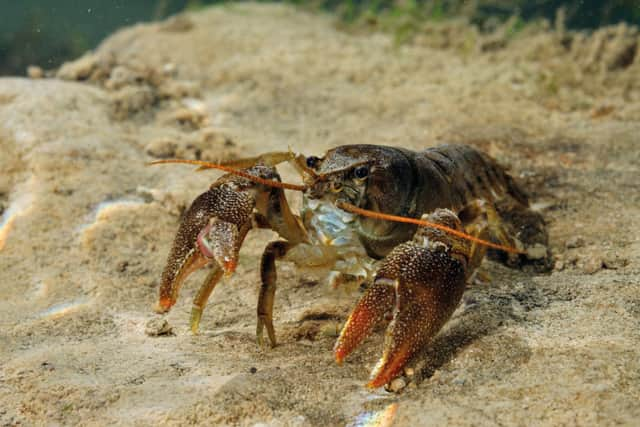Yorkshire crayfish hatchery gets the green light at Flamingo Land


The hatchery at Flamingo Land will hopefully be ready to house captive-born crayfish by spring 2024, with the aim of bringing in wild females with eggs by Summer 2025.
Once the hatchery is fully operational, animals raised there will be used to bolster wild populations around North Yorkshire.
Advertisement
Hide AdAdvertisement
Hide AdThe white-clawed crayfish, Austropotamobius pallipes, is Britain’s only native species of freshwater crayfish and is facing huge declines across North Yorkshire and beyond. As such the NYCF, was created with the aim to bring together different parties, who all share the same ambition - to help conserve the Endangered white-clawed crayfish in North Yorkshire.


The Forum, hosted by Yorkshire Wildlife Trust, covers everything from monitoring populations, education, networking, research, and ark site creation.
Flamingo Land joined the forum in 2021 and in 2022, discussions began about establishing a hatchery to increase the number of crayfish surviving through the most vulnerable stages of their life cycle.
In 2023, funding was awarded via Natural England’s Species Recovery Programme, to commence the “Claws for Thought: saving North Yorkshire’s native crayfish” project.
Advertisement
Hide AdAdvertisement
Hide AdIn this project Yorkshire Wildlife Trust along with the Yorkshire Dales Rivers Trust, Flamingo Land and other members of the NYCF will create new, and enhance existing, ark sites and establish a hatchery (to help bolster populations and support ark sites).
A white-clawed crayfish. Photo courtesy of Laurie Ramsey North Yorkshire’s Crayfish populations are undergoing declines due to habitat loss, pollution and competition from invasive species, primarily the signal crayfish, which carries crayfish plague - a disease that can cause 100% mortality in a native population.
Due to increased pressure from these threats and the increased vulnerability to predators, only about 5% of young crayfish survive to adulthood; however, the Flamingo Land hatchery may increase the survival rate by up to 90%.
Vanessa Barlow, Crayfish Stakeholder Officer at Yorkshire Wildlife Trust, said: "This is a very exciting collaborative project that works towards NYCF’s vision of protecting North Yorkshire’s native crayfish.
Advertisement
Hide AdAdvertisement
Hide Ad"White-clawed crayfish have drastically declined in the last 30 years and are at the risk of extinction in the UK – but this is a fantastic project to improve their prospects and the prospects for other wildlife in North Yorkshire’s rivers.
"By utilising different forum member’s skills and expertise, this project illustrates precisely why the forum was first set up in 2019. Hatcheries are a key tool for crayfish conservation and will massively improve this species’ chance of survival in North Yorkshire.”
Once operational the plan is to bring in a small number of wild females carrying eggs, known as berried females, to the hatchery where they will be carefully looked after until their eggs have hatched.
Once the females have stopped caring for the young, which happens fairly quickly in crayfish, they will then be released back into the water bodies they came from, while the offspring will receive expert care from the team as they grow healthier and become stronger.
Advertisement
Hide AdAdvertisement
Hide AdThe young crayfish will remain in the hatchery until they have grown to a suitable size before release, so they stand the best chance of survival back in the wild. After being health checked other members of the NYCF will collect them and release them into suitable ark sites across the county.
Flamingo Land’s conservation officer Kieran Holliday said: “This is an extremely ambitious project for us here, and we are proud to be involved in a programme that could help with the conservation of a unique and keystone Endangered species.
"We have had guidance from Jen Nightingale, the UK Conservation Manager for Bristol Zoological Society, who is an expert in white-clawed crayfish, and this hatchery is an amalgamation of her vision and vast knowledge, and I am truly thankful for her help.
"I am keen for Flamingo Land to be a key player in native species conservation in North Yorkshire and beyond, and my ambition is that we continue to get involved in these breeding, release and rewilding projects to a point where Flamingo Land is a key stakeholder in North Yorkshire conservation.
Advertisement
Hide AdAdvertisement
Hide Ad"Working with local conservation organisations such as Yorkshire Wildlife Trust is a sure-fire way of us building towards this aim.”
While a first for North Yorkshire, there are a number of other successful, white- clawed crayfish hatcheries around the UK that have been in use for a number of years.
The exciting element about this hatchery is that it builds on their experiences, and will be the first to incorporate solar power, in addition to the standard practise of rainwater harvesting.
These elements help to fulfill Flamingo Land’s ambition to be more sustainable.
Advertisement
Hide AdAdvertisement
Hide AdThe hatchery will hopefully have an educational impact on visitors in regard to the plight of this species and the steps everyone can take to try and help them.
Kieran said: “The spread of the signal crayfish is a serious threat but the fact they carry crayfish plague adds another problem. While not harmful to humans, we can accidentally carry plague spores via our boots and clothing if we walk through an infected watercourse.
"Therefore, as a population, we can also pose a threat if we do not check, clean and dry our boots and equipment after being in our waterways.
"We are aiming to try to educate our visitors on the “Check, Clean and Dry” protocols that everyone can easily follow after a walk, which drastically reduces the chance that you will transfer plague to another watercourse where white-clawed crayfish are present.”
Advertisement
Hide AdAdvertisement
Hide AdThis educational aim will be assisted by interpretation and interactive signage. Flamingo Land has also received funding from the Environmental Agency and Yorkshire Water, both members of the NYCF, to help achieve this goal.